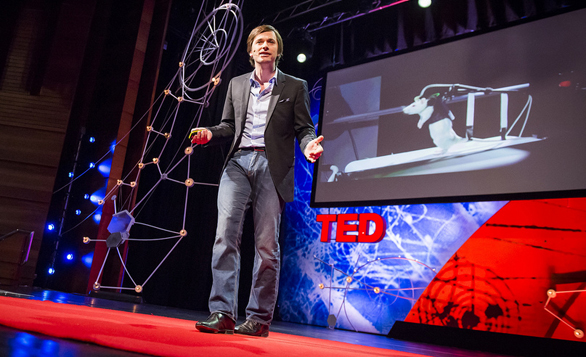
Gregoire Courtine shares the story behind his work at TEDGlobal 2013. It begins with: an encouraging mentor. Photo: James Duncan Davidson
Grégoire Courtine and the scientists in his lab helped a paralyzed rat learn to walk again, voluntarily, through a treatment that combined drugs, electrical stimulation of the lower spinal cord, the support of a robotic arm and a little bit of chocolate. When their study appeared in the June 2012 issue of Science, it sparked a lot of excitement. Articles in Scientific American (“With Willpower, and a Jolt of Electricity, Paralyzed Rats Learn to Walk Again”) and The New York Times (“In Rat Experiment, New Hope for Spine Injuries”) followed, as did a segment on ABC News (“Paralysed rats on ‘incredible’ road to recovery”).
 Grégoire Courtine: The paralyzed rat that walked
Today, Courtine shares the story behind this work. The keys to his breakthroughs: a riveting call to action from Christopher Reeve, and a mentor who encouraged wild experimentation.
Grégoire Courtine: The paralyzed rat that walked
Today, Courtine shares the story behind this work. The keys to his breakthroughs: a riveting call to action from Christopher Reeve, and a mentor who encouraged wild experimentation.
“The spinal cord below most injuries contains all the necessary and sufficient neural network to coordinate locomotion. But because input from the brain is inhibited, they are in a non-functional state — kind of dormant. My idea: we awaken this network,” explains Courtine in today’s talk. “After completing my Ph.D in France, where independent thinking was not exactly encouraged, I was afraid to talk to my new boss … [But] he listened to me carefully and responded with, ‘Why don’t you try?’ This was such an important moment in my career, when I realized that great leaders believe in young people and new ideas.”
In this talk, Courtine shares why his lab’s method worked so well — because it encouraged the brain to make new connections to relay information from the brain to areas below the injury. This, of course, raises a big question — could this treatment work in humans? After all, 50,000 people around the world suffer from spinal cord injuries every year.
Naturally, Courtine hopes so. His team is working hard to develop interventions that could potentially be effective in humans. And a recent study suggests that this may, in fact, be possible.
At the University of Louisville, neuroscientist Susan Harkema — who also studied with Courtine’s mentor, V. Reggie Edgerton — used electrical stimulation to successfully “awaken” a 23-year-old man’s lower spinal cord. In a paper published in The Lancet in June 2011, Harkema shared the amazing results of a study on a patient named Rob Summers. On the very first day of his treatment, Summers was able to stand up on his own. Soon, he was able to move his legs. He later was able to control his bladder and bowel movements, and regained sexual function.
“Rob’s is a pioneer recovery,” Courtine said, in a powerful article in IEEE Spectrum last month about this experiment. “What was surprising to me was that his was better than what we’ve seen in rats. It was really exciting for me to see.”
The U.S. Food and Drug Administration has given Harkema the go-ahead to continue the study with four more patients, to begin determining if the first study was a fluke or if this treatment could work for others. In their article, IEEE Spectrum profiled one of the four patients who will participate — Dustin Shillcox, a 26-year-old from Wyoming who was paralyzed after a car accident.
“I don’t want to be too optimistic, and I’m trying to be prepared for no results at all,” he told the magazine. “I hope that whatever they find from this research will at least benefit other people.”
Both Courtine and Herkema’s work builds on that of Edgerton, who long ago demonstrated that directly stimulating the spinal cord could produce movement, even if communication with the brain wasn’t a possibility. “Everyone, including us, was hung up on the idea that you have to stimulate at this high level to induce the movement,” Edgerton told IEEE Spectrum. And yet, it turned out that low-level stimulation produced far better results, allowing the lower spinal cord to receive sensory feedback from the body.
This story beautifully illustrates how a scientist’s finding is a beginning rather than an ending. One insight can spark subtle variations and brand-new ideas as others pick up the torch and carry the research forward. And while the finish line of a well-tested intervention for spinal cord injuries might be a long way off, it’s a race we are eager to watch.
(Note: For the latest from Courtine’s lab, check out the literature review “Personalized Neuroprosthetics,” published today in Science Translational Medicine.)
Comments (11)
Pingback: A promising first step for those with spinal cord injury – Signal Surgeon
Pingback: Многообещающие открытия для людей с травмой спинного мозга: Как электрические стимуляции помогли не только крысам, но и одному человеку сн
Pingback: A Full Recovery of a Spinal Cord Injury is Possible Law Offices of David Azizi
Pingback: A promising first step for those with spinal cord injury | TED Blog | Investigación en Salud Ambiental y Ecotoxicología
Pingback: MAGIC VIDEO HUB | Surfers who stayed: The video documentary “We Are All Radioactive”